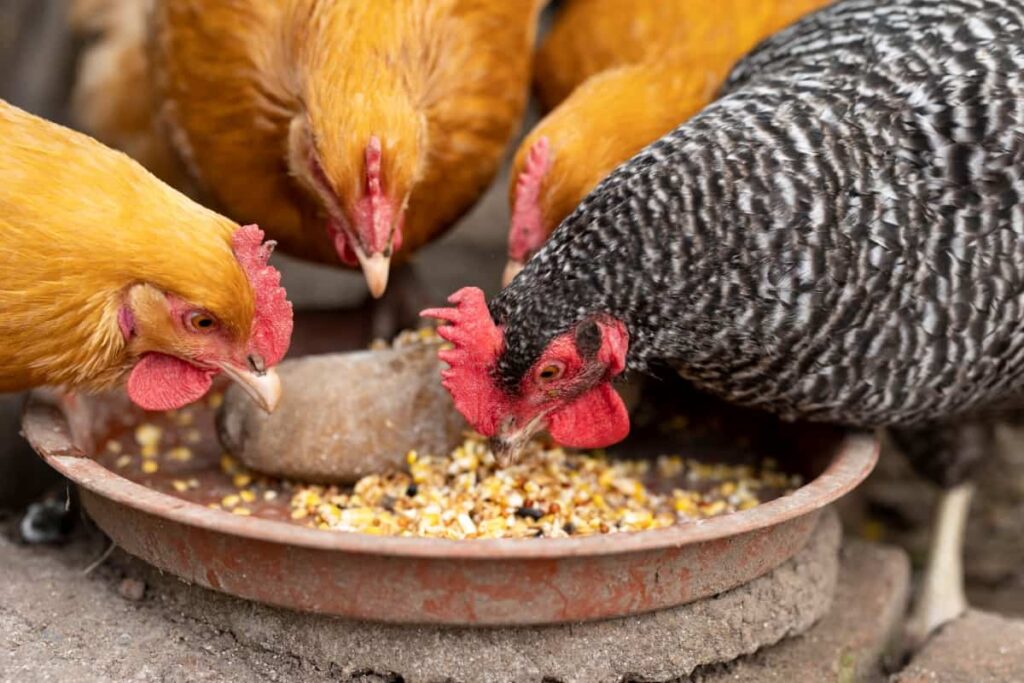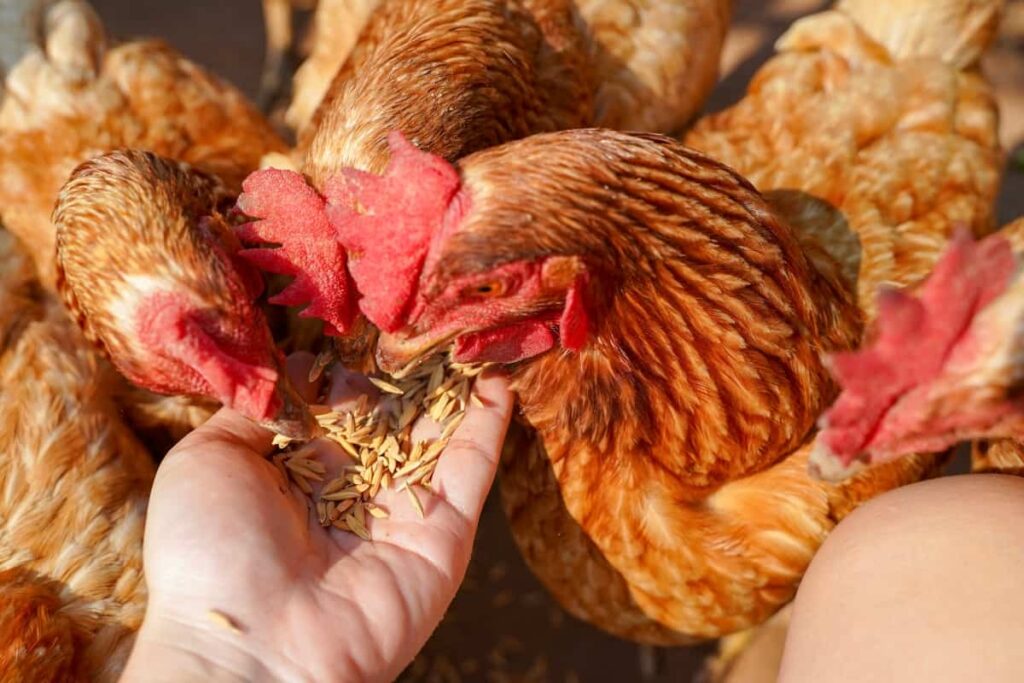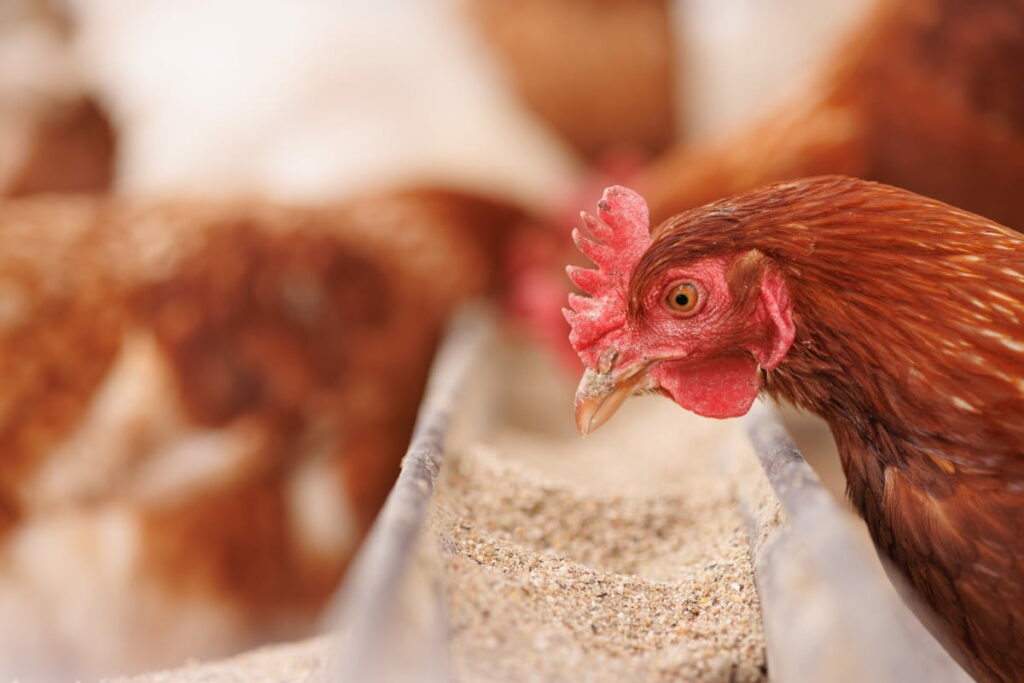Chickens, whether layers or broilers, require a balanced diet to support their growth, egg production (for layers), and overall health. A balanced diet typically consists of protein, energy, vitamins, minerals, and water. Providing proper nutrition is crucial for optimal performance and to prevent health issues.
Benefits of Making Your Feed
- Making chicken feed at home can be more economical than purchasing commercial feeds, especially if you have access to bulk ingredients.
- By backyard chicken diet optimization, you have control over the quality and source of ingredients, ensuring that your chickens receive wholesome and nutritious food.
- Homemade feed allows you to tailor the ingredients to meet the specific nutritional requirements of chickens, whether they are layers or broilers.
- Utilizing locally sourced ingredients and reducing reliance on commercial feeds can contribute to a more sustainable poultry operation.

Ways to Make Chicken Feed at Home
Assessing Nutritional Requirements for Chickens
Different Needs for Layers and Broilers
Layers
- Layers require a diet tailored to support egg production. This means they need higher levels of calcium and certain vitamins compared to broilers.
- Calcium is crucial for layers to produce strong eggshells. Without adequate calcium, eggshell quality can suffer, leading to issues like thin or cracked shells.
Broilers
- They need a higher protein in their diet to support muscle growth and development.
- Energy is also a critical component of broiler diets to support the rapid growth rate typical of meat chickens.
- While broilers still need some calcium for bone development, their calcium requirements are generally lower than layers since they do not produce eggs.
Calculating Protein, Energy, and Mineral Requirements
Protein
- Layers generally require feed with around 16-18% protein to support egg production adequately.
- Broilers, on the other hand, need feed with a higher protein content, typically around 20-22%, to support rapid muscle growth and development.
Energy
- Both layers and broilers require a source of energy to support their metabolic processes and activity levels.
- Energy in the diet is typically provided by grains such as corn, wheat, or barley.
Minerals
- Calcium is essential for both layers and broilers, but layers require higher levels to support eggshell formation.
- Other minerals like phosphorus, potassium, sodium, and magnesium are also important for overall health and various metabolic functions.
Selecting Ingredients for Your Feed
Best Grains for Chicken Feed and Their Benefits
- Corn: Provides energy and is readily available. It’s a staple in many poultry diets.
- Wheat: Another energy-rich grain that also adds bulk to the feed.
- Barley: Provides energy and some protein, suitable for both layers and broilers.
- Oats: Rich in fiber and can help regulate digestion in chickens.
- Sorghum: Another organic chicken feed ingredient and energy-rich grain that is drought-tolerant and suitable for poultry diets.
Protein Sources: Plant vs. Animal
Plant-Based Protein Sources
- Soybean Meal: one of the high-quality protein sources for homemade feed commonly used in poultry diets.
- Canola Meal: Another plant-based protein source rich in essential amino acids.
- Sunflower Meal: Provides protein and healthy fats, suitable for poultry diets.
Animal-Based Protein Sources
- Fish Meal: Rich in protein and essential fatty acids, beneficial for growth and development.
- Meat and Bone Meal: Provides protein, calcium, and phosphorus, supporting bone development.
In case you missed it: How to Raise Delaware Chickens: A Comprehensive Guide for Beginners

Natural Supplements for Chicken Feed
Essential Vitamins and Minerals for Chickens
- Vitamin A: For vision, immune function, and reproduction.
- Vitamin D: For calcium absorption.
- Vitamin E: As an antioxidant, protecting cells from damage.
- Calcium: Crucial for bone and eggshell formation in layers.
- Phosphorus: Necessary for bone development and energy metabolism.
The Role of Grit in Digestion
- Grit, such as small stones or insoluble particles, aids in the mechanical breakdown of food in the chicken’s gizzard.
- Providing grit is especially important for birds that consume whole grains or forages, as it helps grind these materials for better digestion.
- Ensure that grit is available free-choice to your chickens, especially for birds kept in confinement or those with limited access to outdoor foraging.
Equipment and Storage Solutions
Necessary Tools for Mixing Feed
- Grain grinder or mill: Essential for grinding whole grains into smaller particles for easier consumption and digestion.
- Mixing equipment: Such as buckets, scoops, or a feed mixer, to ensure uniform distribution of ingredients.
Best Practices for Storing Homemade Feed
- Use airtight containers: Store feed in sealed containers to prevent moisture, pests, and contamination.
- Keep feed in a cool, dry place: Exposure to heat and humidity can cause spoilage and nutrient degradation.
- Rotate feed regularly: Use older feed first to maintain freshness and nutrient quality.
- Label containers: Clearly label feed containers with the date of production and ingredients to track freshness and ensure proper rotation.
Formulating Your Chicken Feed Recipe: Chicken Feed Formulation Techniques
Calculating Proportions and Ratios
- For a homemade chicken feed recipe, first, Determine the nutritional requirements of your chickens based on factors such as age, breed, purpose (layers or broilers), and production stage (growing, laying eggs, etc.).
- Use nutritional guidelines and tables to calculate the proportions of grains, protein sources, vitamins, minerals, and supplements needed to meet these requirements.
- Adjust ingredient ratios to achieve the desired levels of protein, energy, vitamins, and minerals.
Adjusting Recipes for Age and Purpose
- For Baby Chickens: Formulate feeds with higher protein levels to support growth and development.
- For Laying Hens: Adjust calcium levels to support eggshell formation and include additional vitamins and minerals to support egg production.
- For Broilers: Increase protein levels to support rapid muscle growth and energy levels for efficient meat production.
How to Mix Your Own Chicken Feed: A Step-By-Step Process
Preparing Your Ingredients
- Grind or mill any whole grains to achieve the desired particle size for easier consumption and digestion.
- Measure appropriate amounts of each ingredient based on your formulated recipe.
Techniques for Ensuring Even Mixing
- Use a dedicated feed mixer or thoroughly hand-mix the ingredients in batches to ensure uniform distribution.
- Mix smaller batches initially to facilitate thorough blending before scaling up production.
Testing and Adjusting Your Feed
Observing Your Chickens’ Health and Performance
- Monitor your chickens’ overall health, behavior, and performance regularly.
- Look for signs of nutritional deficiencies or imbalances, such as poor feather quality, reduced egg production, or slow growth rates.
Making Adjustments Based on Feedback
- If you observe any issues with your chickens’ health or performance, review your feed formulation and consider adjusting ingredient ratios or adding supplements as needed.
- Consult with a poultry nutritionist or veterinarian for guidance on making appropriate adjustments to your feed recipe.
In case you missed it: Raising Ancona Chickens: A Complete Guide to Care, Breeding, and Benefits

Advanced Tips for Optimizing Feed
Fermenting Grains for Improved Digestibility: Fermented Chicken Feed Benefits
- Fermenting grains before feeding can enhance their digestibility and nutrient availability for chickens.
- Fermentation breaks down complex carbohydrates and anti-nutrients, making nutrients more accessible to the chickens.
- To ferment grains, soak them in water for some time (usually 12-24 hours), allowing beneficial bacteria to proliferate and initiate fermentation. Drain excess water before feeding.
Sprouting Seeds to Enhance Nutrient Availability
- Sprouting seeds initiates biochemical changes that increase nutrient content and availability.
- Vitamins, minerals, antioxidants, and enzymes are abundant in sprouted seeds, making them highly nutritious for chickens.
- To sprout seeds, soak them in water for several hours, then rinse and drain regularly until sprouts emerge. Feed the sprouted seeds to your chickens when they reach the desired length.
Safety and Quality Control
Identifying and Avoiding Contaminated Ingredients
- Regularly inspect ingredients for signs of contamination, such as mold, pests, or unusual odors.
- Source ingredients from reputable suppliers with stringent quality control measures in place.
- Store ingredients properly in clean, dry, and airtight containers to prevent contamination and spoilage.
Regularly Updating Your Feed Formula
- Periodically review and update your feed formulation based on factors such as changes in chicken age, breed, production stage, or seasonal variations in ingredient availability.
- Consider incorporating new research findings or advancements in poultry nutrition to optimize your feed formula for improved performance and health.
In case you missed it: Top 13 Tallest Chicken Breeds in the World

Conclusion
In conclusion, crafting homemade chicken feed offers cost-effectiveness, ingredient control, and customization to meet the distinct nutritional needs of layers and broilers. With vigilant safety measures and periodic formula updates, poultry owners can ensure their flocks receive nutritious, cost-effective poultry feed solutions for optimal health and productivity.
- Aquaponic Farming at Home: A Step-By-Step Guide
- Profitable Village Farming Business Ideas in 2024
- High-Yield Aquaculture: Fast-Growing Fish for Farming
- Effective Fish Pond Construction Techniques for Beginners
- Irrigation and Water Management in Pineapple Farming
- Blossom to Harvest: Mastering Flowering and Pollination in Papaya Farming
- Pig Fattening Essentials: From Selection to Sale for Beginners
- Raising Wagyu Cattle: A Complete Guide for Premium Beef Production
- Soil Types and Their Water Holding Capacity
